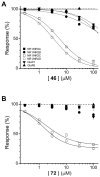Quinazolin-4-one derivatives: A novel class of noncompetitive NR2C/D subunit-selective N-methyl-D-aspartate receptor antagonists
- PMID: 20684595
- PMCID: PMC2920070
- DOI: 10.1021/jm100027p
Quinazolin-4-one derivatives: A novel class of noncompetitive NR2C/D subunit-selective N-methyl-D-aspartate receptor antagonists
Abstract
We describe a new class of subunit-selective antagonists of N-methyl D-aspartate (NMDA)-selective ionotropic glutamate receptors that contain the (E)-3-phenyl-2-styrylquinazolin-4(3H)-one backbone. The inhibition of recombinant NMDA receptor function induced by these quinazolin-4-one derivatives is noncompetitive and voltage-independent, suggesting that this family of compounds does not exert action on the agonist binding site of the receptor or block the channel pore. The compounds described here resemble CP-465,022 ((S)-3-(2-chlorophenyl)-2-[2-(6-diethylaminomethyl-pyridin-2-yl)-vinyl]-6-fluoro-3H-quinazolin-4-one), a noncompetitive antagonist of AMPA-selective glutamate receptors. However, modification of ring substituents resulted in analogues with greater than 100-fold selectivity for recombinant NMDA receptors over AMPA and kainate receptors. Furthermore, within this series of compounds, analogues were identified with 50-fold selectivity for recombinant NR2C/D-containing receptors over NR2A/B containing receptors. These compounds represent a new class of noncompetitive subunit-selective NMDA receptor antagonists.
Figures





References
-
- Rudhard Y, Kneussel M, Nassar MA, Rast GF, Annala AJ, Chen PE, Tigaret CM, Dean I, Roes J, Gibb AJ, Hunt SP, Schoepfer R. Absence of Whisker-related pattern formation in mice with NMDA receptors lacking coincidence detection properties and calcium signaling. J. Neurosci. 2003;23:2323–2332. - PMC - PubMed
-
- Colonnese MT, Shi J. Constantine-Paton, M., Chronic NMDA receptor blockade from birth delays the maturation of NMDA currents, but does not affect AMPA/kainate currents. J. Neurophysiol. 2003;89:57–68. - PubMed
-
- Waters KA, Machaalani R. Role of NMDA receptors in development of respiratory control. Respir. Physiol. Neurobiol. 2005;149:123–130. - PubMed
-
- Nacher J, McEwen BS. The role of N-methyl-D-asparate receptors in neurogenesis. Hippocampus. 2006;16:267–270. - PubMed
Publication types
MeSH terms
Substances
Grants and funding
LinkOut - more resources
Full Text Sources
Other Literature Sources
Chemical Information
Miscellaneous

